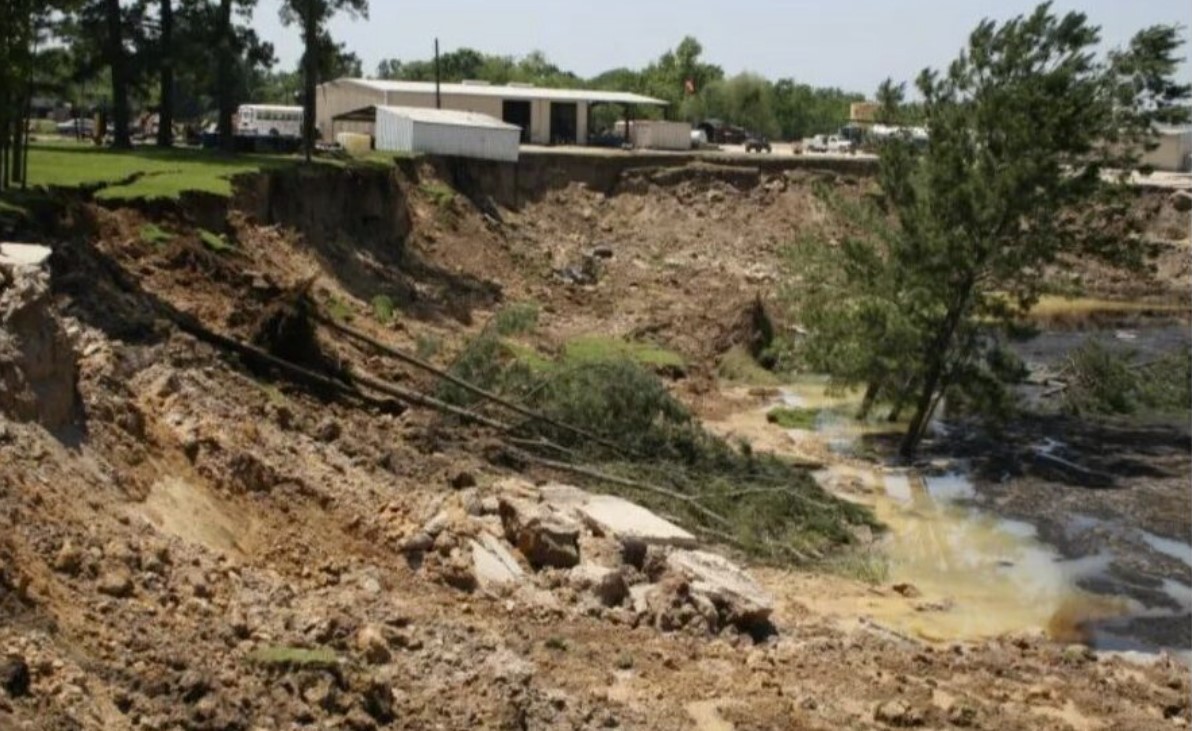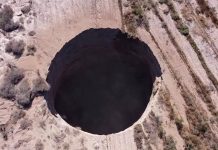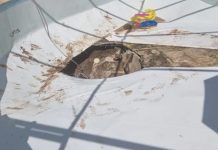A mining crew drilled through the bottom of a lake and into a salt mine. As the lake begins to drain into the mine, a whirlpool forms, sucking down barges, kilometers of land and reversing the flow of the Gulf of Mexico. Lake Peigneur is located in the U.S. State of Louisiana 1.2 miles (1.9 km) north of Delcambre and 9.1 miles (14.6 km) west of New Iberia, near the northernmost tip of Vermilion Bay.
As at the louisiana sinkhole, a gas company (Atlanta Gas Light or (AGL) Resources) stores gas in the salt dome under Lake Peigneur since 1994 despite the castastrophy of 1980 resulting in weird and unusual bubbling events at the surface of the water about which residents are worried. The salt domes are unstable and these gases may represent a threat to their community.
Now in light of the catastrophe in Assumption Parish (Louisiana sinkhole) it would be nice that AGL Resources/Jefferson Island Storage & Hub voluntarily withdraw their permit application. But they do not want.
Is Governor Jindal going to use his privilege as Governor to deny the permit application and block all future requests for salt cavern storage at the Jefferson Island Salt Dome? Hope so! He already declared that the situation at the Louisiana sinkhole would fit in the record books.
History of Lake Peigneur
The lake was a 10-foot (3 m) deep freshwater lake popular with sportsmen until an unusual man-made disaster on November 20, 1980, changed the structure of the lake and surrounding land.
Drilling disaster
On November 20, 1980, when the disaster took place, the Diamond Crystal Salt Company operated the Jefferson Island salt mine under the lake, while a Texaco oil rig drilled down from the surface of the lake searching for petroleum. Due to a miscalculation, the 14-inch (36 cm) drill bit entered the mine, starting a chain of events which turned what was at the time an almost 10-foot (3.0 m) deep freshwater lake into a salt water lake with a deep hole.
It is difficult to determine exactly what occurred, as all of the evidence was destroyed or washed away in the ensuing maelstrom. One explanation is that a miscalculation by Texaco regarding their location resulted in the drill puncturing the roof of the third level of the mine.
This created an opening in the bottom of the lake. The lake then drained into the hole, expanding the size of that hole as the soil and salt were washed into the mine by the rushing water, filling the enormous caverns left by the removal of salt over the years. The resultant whirlpool sucked in the drilling platform, eleven barges, many trees and 65 acres (260,000 m2) of the surrounding terrain. So much water drained into those caverns that the flow of the Delcambre Canal that usually empties the lake into Vermilion Bay was reversed, making the canal a temporary inlet. This backflow created, for a few days, the tallest waterfall ever in the state of Louisiana, at 164 feet (50 m), as the lake refilled with salt water from the Delcambre Canal and Vermilion Bay. The water downflowing into the mine caverns displaced air which erupted as compressed air and then later as 400-foot (120 m) geysers up through the mineshafts.
There were no injuries and no human lives lost. All 55 employees in the mine at the time of the accident were able to escape thanks to well-planned and rehearsed evacuation drills, while the staff of the drilling rig fled the platform before it was sucked down into the new depths of the lake, and Leonce Viator, Jr. (a local fisherman) was able to drive his small boat to the shore and get out.Three dogs were reported killed, however. Days after the disaster, once the water pressure equalized, nine of the eleven sunken barges popped out of the whirlpool and refloated on the lake’s surface.
Salinity
The lake had salt water after the event, not as a result of water entering the salt mine, but from the salt water from the Delcambre Canal and Vermilion Bay, which are naturally salt or brackish water. The event permanently affected the ecosystem of the lake by changing the lake from freshwater to saltwater and increasing the depth of part of the lake.












